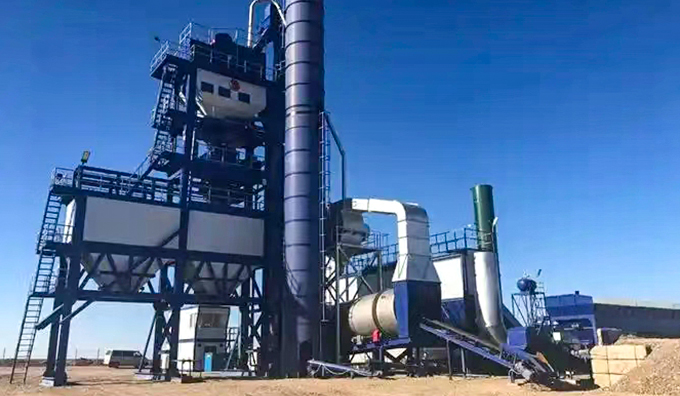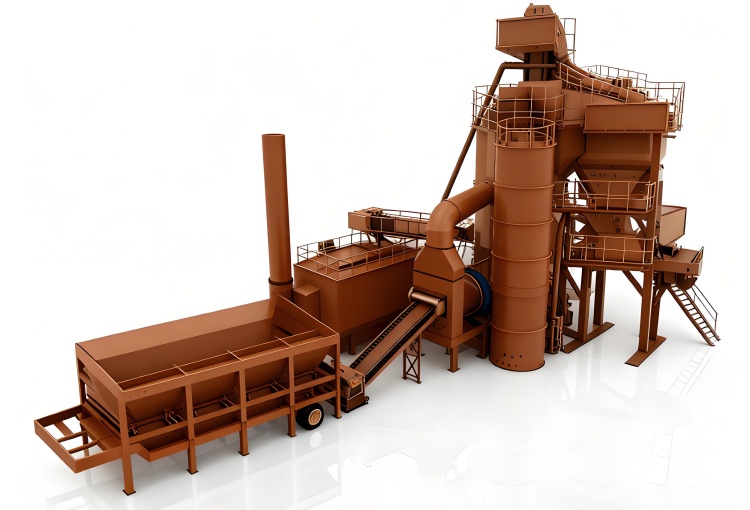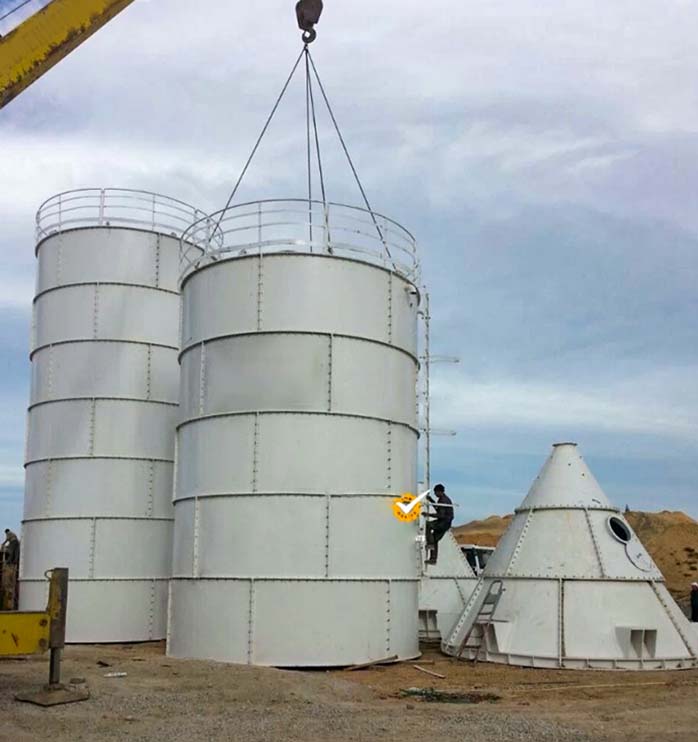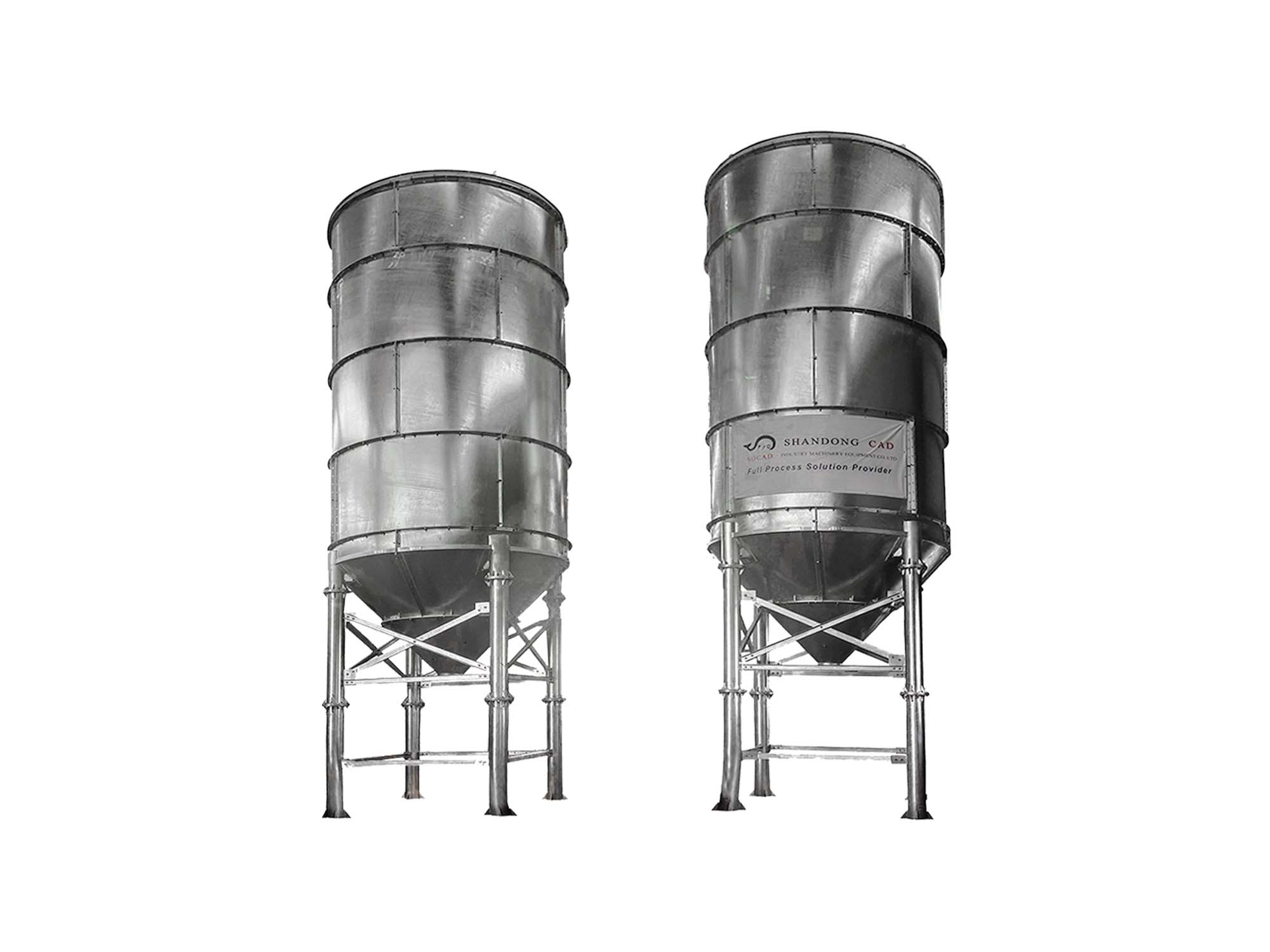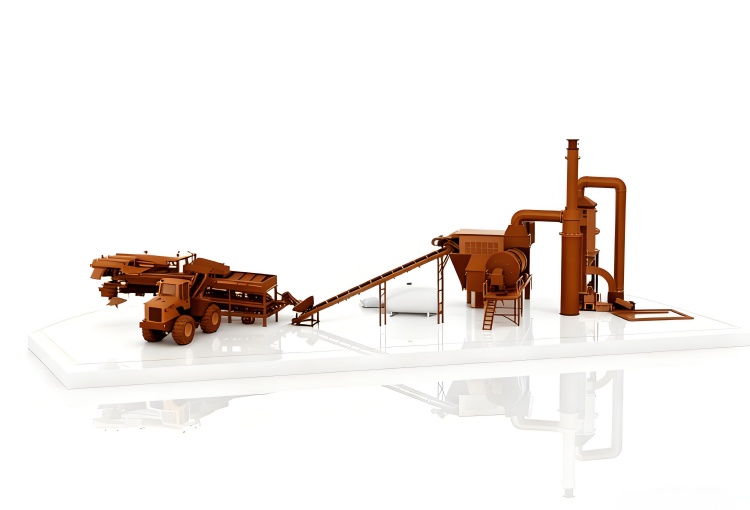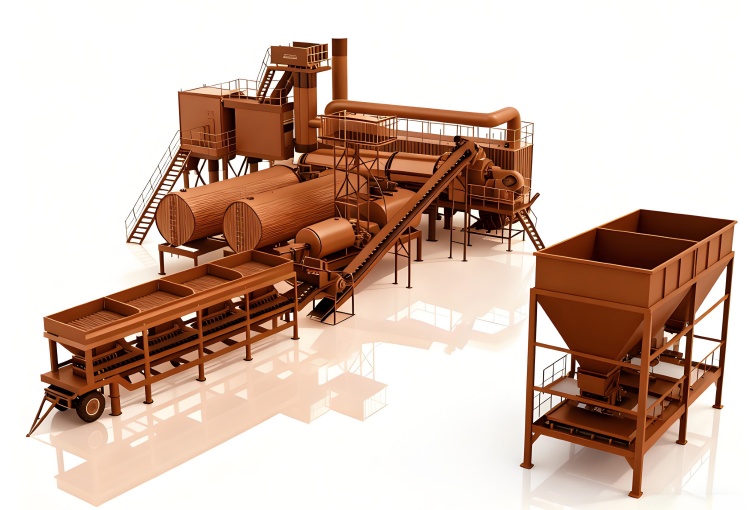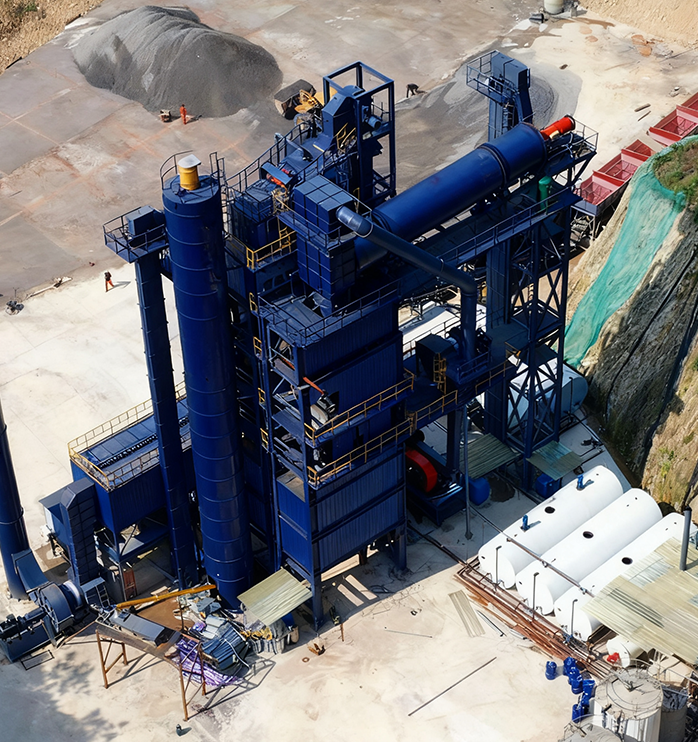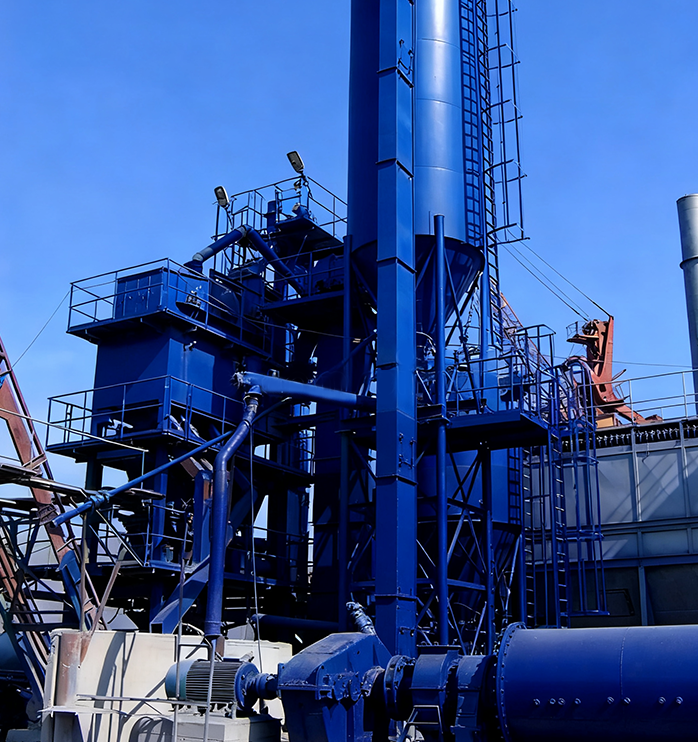modern asphalt batch mix plant sits at the center of every road-building project, determining pavement durability, production efficiency, fuel consumption, and overall project cost. Contractors, supervisors, and procurement teams often ask the same critical question: How exactly does the asphalt batching process work, and which factors influence performance, reliability, and long-term ROI?
The answer requires more than a simple flow description. Each stage has engineering logic, operational risks, and quality-sensitive mechanisms that affect mix stability, gradation accuracy, binder adhesion, and temperature consistency. Any minor deviation can lead to premature rutting, early cracking, moisture damage, or failed compaction on-site.
Projects in regions with fluctuating moisture content, unstable aggregate supply, or inconsistent power infrastructure face additional pressures. Production managers must maintain ISO-level repeatability while still meeting tight deadlines and budget constraints. Plant operators demand clarity about airflow control, baghouse breathing cycles, burner flame stability, and temperature recovery curves, because all these variables directly influence ton-per-hour productivity.
SDCAD has supplied thousands of asphalt mixing systems to global clients. Across Africa, Southeast Asia, Europe, and South America, our teams frequently observe the same pattern: contractors struggle not because of low equipment quality but because they lack a detailed understanding of the batch production sequence and the hidden factors that shape the final mix.
A detailed explanation is the foundation for better operation, smarter maintenance, and more profitable long-term decisions.
Understanding the Complete Workflow Inside an Asphalt Mixing Plant
The heart of every asphalt mixing plant is its controlled, repeatable, temperature-stable batching sequence. Each stage moves raw aggregates through a defined path: cold feeding, drying, heating, screening, storage, mixing, and bitumen integration. The cycle must synchronize mechanical, thermal, pneumatic, and control elements into a single coordinated system.
The workflow always begins at the cold feed unit. Operators load aggregates of different sizes into separate hoppers, adjusting feeder gate openings and belt speeds based on the required mix design. A mistake here—such as oversized gate openings or unstable belt calibration—can shift the gradation curve and damage mixture consistency long before aggregates reach the dryer drum.
Inside the dryer, the aggregate moisture content becomes the primary variable. Wet materials absorb heat, extending the drying curve and demanding higher burner output. If the burner fails to maintain flame stability, temperature fluctuations create uneven heating, leading to thermal shock inside the dryer drum. These irregularities later push mix temperatures out of tolerance, causing compaction difficulties on the paving site.
After drying, heated aggregates are lifted to the vibrating screen deck. Each screen layer separates materials into defined size categories. A failure here—such as torn mesh or excessive vibration amplitude—allows improper sizes to slip through the gradation system. In many developing regions, screens are not replaced at proper intervals, resulting in inaccurate batching and increased waste.
Aggregates fall into hot bins, where they remain briefly before batching begins. Load cells measure precise aggregate weight, while the mixer receives each size category according to job mix formula demands. Bitumen flows into the mixer at a controlled temperature to ensure proper coating, while mineral filler reinforces the void structure.
The mixing chamber completes the cycle, forming consistent hot mix asphalt ready for discharge. A plant that executes this sequence with minimal variation provides contractors the stability they need to maintain QC standards even under high output.
Process Breakdown Inside an Asphalt Plant With Component-Level Detail
Every stage of asphalt production contains engineering principles that define its performance. Contractors often request an asphalt batch plant diagram to visualize this path, and while drawings help, the real understanding comes from knowing why each subsystem exists and how failure modes propagate.
Cold Aggregate Feeding System Within an Asphalt Mixing Plant
Cold bin feeders decide the first point of accuracy. Each hopper holds a single aggregate size, preventing contamination. The feeding belts work through independent VFD controls, allowing operators to fine-tune material proportions before drying.
When improperly calibrated, the feeders produce inconsistent flow, leading to unstable mix design even if the rest of the process operates perfectly. Global buyers often ask about komponen asphalt mixing plant systems, and the cold feeding mechanism is usually among the most underestimated components.
Project managers working in remote regions often face variations in aggregate grading from local quarries. Adjustable feeders compensate for these inconsistencies, ensuring stable quality even when raw material sources change.
Drying and Heating Mechanism Inside the Asphalt Mixing Plant
The dryer drum handles the largest thermal load. Aggregates must move counterflow or parallel flow against the burner flame depending on plant design. Burner efficiency defines fuel consumption, drying speed, and temperature stability.
Many clients searching for asphalt hot mix plant near me prioritize burner quality because unstable flames produce uneven aggregate heating, which later affects binder adhesion.
Inside the drum, specially designed flights lift and cascade aggregates, ensuring maximum heat transfer. A weak flight design increases fuel consumption and extends drying time, reducing hourly production capacity. The burner, airflow ducting, and baghouse suction must be balanced to prevent excessive dust carryover or heat loss.
Screening and Hot Bin Storage in the Asphalt Mixing Plant
Once aggregates exit the dryer, they enter a high-speed bucket elevator and reach the vibrating screens. Each screen layer contains calibrated openings that separate aggregates into categories for batching.
Damage to the screen mesh can alter the entire distribution curve, which is why inspection frequency needs to follow a strict maintenance cycle.
After screening, aggregates are stored in hot bins. Load cell sensors and gates ensure accurate discharge into the weighing system. Aggregates must remain at stable temperatures to maintain the required bitumen viscosity during mixing.
Mixing Stage Inside the Asphalt Plant
The mixing chamber integrates aggregates, bitumen, and filler. Twin-shaft mixers dominate the market due to their ability to produce uniform coating within short cycles.
Contractors comparing a stationary asphalt mixing plant with a mobile unit often prioritize mixer capacity, blade design, and liner durability. A high-quality mixer influences mix homogeneity and reduces asphalt segregation during transport.
At this stage, bitumen pumps inject binder at a controlled temperature. If the bitumen cools too much, coating efficiency drops, forcing longer mixing cycles and increasing energy consumption.
Problem Origins Inside an Asphalt Mixing Plant Affecting Production Quality
Asphalt production issues rarely happen due to a single failure. They usually arise from a chain of small inaccuracies that accumulate through the workflow. Understanding these root causes helps operators prevent defects that could later appear on the road surface.
One major origin stems from inconsistent aggregate moisture content. Excessive moisture forces the dryer drum to work harder, delaying heating stabilization and reducing hourly output. When contractors use local river aggregates or store materials without covers, moisture fluctuations create unpredictable drying loads.
Thermal inconsistencies inside the dryer drum form another critical origin. If burner output varies or airflow is unstable, aggregates exit at temperatures outside the mix specification. This can cause premature aging of bitumen or insufficient coating, leading to surface raveling months after construction.
Gradation instability also emerges from poor screening maintenance. A screen with worn mesh produces mixed-size aggregates that fail to match job mix formulas. The result is weakened internal structure and higher voids-in-mineral-aggregate (VMA), reducing pavement life.
Bitumen temperature deviations frequently appear when storage tanks lack proper insulation or circulation. Cooler bitumen becomes too viscous, preventing proper coating, forcing the mixer to work longer and reducing its throughput.
Environmental factors such as high dust loads, insufficient baghouse airflow, or unstable power grids also affect production reliability. Some regions require plants to operate in extremely humid climates, which can cause temperature drops during material transfer, affecting final discharge temperature.
Operational habits add another layer. Incorrect feeder settings, poorly calibrated belts, delayed mixer blade replacement, and inaccurate weighing systems all contribute to long-term quality issues.
These origins define why many clients exploring asphalt batching plant price differences must look beyond hardware cost. The real value comes from a design that minimizes risk, provides stable production, and reduces the long-term cost per ton.
Detailed Step-by-Step Working Process of an Asphalt Plant
A complete cycle inside a modern batching system follows a predictable path, but each step contains specific engineering logic. Understanding this process helps project managers, supervisors, and asphalt technicians operate more confidently.
Material Loading and Cold Feeding
Aggregates arrive at the cold bin area. Each bin stores a single gradation, while adjustable gates and belts control flow. Operators set belt speeds based on job mix requirements. A poorly adjusted gate produces incorrect proportions, forcing later corrections that waste time and material.
Aggregate Conveying to the Dryer
A collecting belt transports all cold materials to the dryer drum. The collecting conveyor must maintain constant speed to prevent material surges. Belt misalignment creates uneven feed rates and overloads the dryer’s thermal system.
Drying and Heating Process
Inside the dryer drum, aggregates meet hot air generated by the burner. Flights lift materials and distribute them uniformly for heat transfer. Burner control systems maintain flame stability through automatic air–fuel ratio monitoring. The drying process targets moisture evaporation while avoiding superheating.
Clients searching for a continuous asphalt mixing plant often compare how drying efficiency differs from batch systems.
Dust Collection Through the Baghouse
Fine particles enter the baghouse through controlled airflow. Filters trap dust and allow clean air to escape. Collected dust may be reused as filler. Baghouse performance determines emissions compliance and internal air pressure stability.
Hot Aggregate Elevation
A bucket elevator transfers dried aggregates to the top screening deck. The elevator requires precision alignment. Misalignment causes spillage, increased wear, or blocked flow.
Screening for Gradation Control
Vibrating screens classify aggregates into size categories. The screening amplitude and motor speed affect accuracy. Hard aggregates gradually wear the mesh, demanding routine inspection.
Hot Bin Storage and Weighing
Aggregates fall into separate hot bins. Load cells weigh each component based on mix design inputs. Accurate weighing ensures consistent mix quality. A minor weighing error can shift final void ratio and binder demand.
Bitumen Heating and Supply
Bitumen pumps transfer heated binder to the mixing chamber. Tank insulation, circulation loops, and temperature sensors maintain viscosity. A stable bitumen line prevents premature cooling during transfer.
Many buyers evaluating asphalt mixing plant price often overlook the value of efficient bitumen systems, which influence long-term operational cost more than expected.
Filler Storage and Addition
Mineral filler stabilizes the internal mixture structure. Filler flows from storage silos into weighing systems before entering the mixer. Poor filler flow results from moisture contamination or blocked screw conveyors.
Mixing Cycle
Aggregates, bitumen, and filler enter the mixer. Twin-shaft paddles blend materials, ensuring uniform distribution and coating. Mixing duration depends on plant design and mix requirements. Contractors comparing offers from asphalt mixing plant manufacturers usually evaluate mixer blade design, liner durability, and drive system efficiency.
Discharge to Storage Silo or Truck
Hot mix asphalt is discharged into silos or directly into trucks. Silo insulation and anti-segregation systems protect mix temperature and prevent coarse aggregate separation.
Plants such as mobile asphalt mixing plant units may discharge directly due to compact design.
Challenges Contractors Face During the Asphalt Mixing Plant Process
Projects often run into predictable issues that affect production quality and output. These challenges appear across climates, aggregate sources, and job specifications.
Moisture variability remains one of the most influential factors. Aggregates stored in open yards absorb water quickly, forcing the dryer to work harder. Regions with frequent rainfall or high humidity experience fluctuating production speeds, increasing fuel consumption and extending drying times.
Temperature recovery inside the mixer becomes another common challenge. When aggregates arrive too cool due to long transfer paths or unstable burner output, bitumen coating becomes inefficient. Operators may extend mixing times, which reduces hourly productivity and stresses mixer blades.
Gradation inaccuracies remain widespread. Screen wear, hopper contamination, or incorrect cold feeder settings shift the expected gradation curve. Quality engineers must constantly monitor sieve analysis results to ensure the mix remains within specification.
Dust control failures also influence performance. A baghouse with clogged filters reduces airflow, creating negative pressure issues that affect dryer efficiency. Poor dust capture can also cause environmental violations, forcing production stoppages.
Electrical instability creates unpredictable downtime in many developing countries. Sensitive components such as frequency inverters, PLC systems, and burner controllers require stable voltage to operate properly.
Transport distance between plant and jobsite introduces another variable. Long hauls require higher discharge temperatures, increasing fuel consumption and potentially aging the bitumen.
All these challenges reinforce the need for strong operational discipline and a plant design capable of maintaining stable performance under changing conditions.
Contractors comparing a mobile asphalt batch plant with fixed installations often choose mobility to reduce haul distances and protect mix quality.
Component Selection and Plant Configuration Considerations in Asphalt Mixing Plant Design
Choosing the right configuration helps contractors match plant performance to project demands. Each component affects reliability, output, and long-term operational cost.
Larger projects require higher capacity mixers and more powerful burners to maintain consistent hourly productivity. Smaller municipal projects may prioritize mobility, choosing compact units such as asphalt mixing plant portable models with simpler installation requirements.
Dust collection capacity must align with drying load. Undersized baghouse systems create bottlenecks, forcing operators to reduce output or risk environmental non-compliance.
Aggregates with high fines content demand stronger baghouse suction and more durable filter bags.
Plant layout also influences workflow efficiency. A well-designed layout minimizes heat loss during material transfer, reduces conveyor wear, and shortens operator movement. Buyers examining asphalt mixing plant layout options often choose configurations that optimize fuel economy and reduce maintenance intervals.
Certain markets rely on smaller production volumes and prefer compact systems like asphalt mixing plant mini units. These offer lower output but provide fast installation and easy relocation.
In regions requiring colder pavement mixtures, cold mix asphalt plant for sale units gain attention because they eliminate the need for intense heating. However, these plants serve different applications and cannot replace hot mix systems used for highways.
Contractors purchasing from asphalt batch mix plant exporters must evaluate shipping requirements, installation constraints, and climate challenges that influence plant performance.
Advanced Operation Strategies for Asphalt Mixing Plant Efficiency
Maintaining consistent quality and production output in an asphalt mixing plant demands meticulous attention to operational procedures. Operators must regularly calibrate the aggregate feeder systems to ensure that each type of material is weighed accurately. Implementing automated control systems can significantly reduce human error and improve repeatability across batches. In high-capacity plants, synchronization of multiple components such as hot bins, dryers, and mixers is essential to prevent bottlenecks.
Routine checks on burner efficiency are critical for asphalt hot mix plant near me operations. Flame stability directly impacts the heating of aggregates and the uniformity of the asphalt mixture. Additionally, monitoring fuel consumption and adjusting burner settings can optimize energy usage, reducing operational costs. Operators are encouraged to maintain detailed logs for temperature, feed rate, and mixing times to identify trends and prevent deviations before they affect production quality.
Optimizing Asphalt Plant Layout for Smooth Workflow
The layout of an asphalt plant directly affects productivity and safety. Proper positioning of aggregate storage, batching units, and conveyor paths minimizes material handling time and reduces potential spillage. A well-designed asphalt mixing plant layout incorporates separate zones for loading, mixing, and storage, allowing operators to conduct simultaneous tasks without interference.
To further enhance workflow, mobile asphalt mixing plant portable units can be deployed on project sites. Their compact design reduces transport time and allows for flexible placement relative to paving locations. By integrating dust collection systems and access platforms strategically, maintenance can be performed without disrupting the production process. This approach increases uptime and ensures consistent asphalt quality across multiple project sites.
Preventive Maintenance Plans for Asphalt Mixing Plant Longevity
A detailed preventive maintenance program is fundamental to extending the service life of an asphalt plant. Critical components such as the mixer, burners, and aggregate bins require scheduled inspection, lubrication, and replacement when necessary. Maintenance intervals should be determined based on production volume, environmental conditions, and historical wear patterns.
Checking conveyor belts and augers for alignment and wear prevents unplanned downtime. For stationary asphalt mixing plant setups, vibration analysis on motors and gearboxes can predict potential failures before they cause major disruptions. Regular cleaning of the dryer and dust collection system reduces the risk of blockages and fire hazards. Implementing predictive maintenance software can help monitor equipment performance in real time, providing alerts when deviations occur.
Quality Control Procedures in Asphalt Concrete Mixing Plant
Ensuring high-quality output in an asphalt concrete mixing plant begins with raw material verification. Aggregates should be screened for size consistency, and bitumen content must meet project specifications. Temperature control during mixing is vital, as variations can compromise the workability and durability of asphalt.
Laboratory testing of each batch, including penetration, viscosity, and gradation analysis, allows operators to maintain strict adherence to design parameters. Using automated batching systems for asphalt batch plant diagram control ensures precise ingredient ratios, improving consistency across large-scale production. Maintaining a robust quality management system enhances customer trust and reduces the likelihood of rework, which saves both time and cost on long-term projects.
Cost Optimization Strategies for Asphalt Batch Mix Plants
Controlling production costs is a priority for any asphalt batch mix plant exporters or local operator. Implementing energy-efficient burners, optimizing mix schedules, and reducing idle times contribute directly to lower operating expenses. Strategic bulk purchasing of aggregates and bitumen can also reduce material costs, while careful inventory management prevents waste and spoilage.
Operators can adopt lean manufacturing principles, aligning production with project timelines to minimize overproduction. Utilizing data from plant control systems allows managers to evaluate the cost per ton of asphalt accurately, enabling informed decisions regarding resource allocation and labor deployment. Additionally, selecting the right type of plant—whether a mobile asphalt batch plant or a stationary configuration—can influence both initial investment and ongoing operational efficiency.
Integrating Continuous Asphalt Mixing Plant Technology
Continuous asphalt mixing plant technology offers a significant advantage for high-demand paving projects. Unlike batch plants, continuous systems produce asphalt without interruption, improving overall productivity and reducing material segregation. Incorporating modern PLC control units ensures that temperature, feed rate, and mixing speed are constantly monitored, allowing rapid adjustments in real time.
For projects requiring rapid turnaround, continuous plants can provide a steady supply of asphalt directly to paving machines, minimizing the need for storage and handling. This configuration also reduces fuel consumption per ton of asphalt produced, contributing to a smaller environmental footprint. Integrating remote monitoring allows engineers to oversee multiple sites simultaneously, optimizing resource use and reducing on-site staffing needs.
Enhancing Safety Protocols in Asphalt Mixing Plant Operations
Safety is critical in any asphalt plant manufacturers environment. High temperatures, moving machinery, and combustible materials necessitate strict adherence to safety protocols. Personal protective equipment, regular staff training, and clearly marked emergency procedures reduce accident risk.
Monitoring systems, such as temperature alarms and conveyor guards, help prevent equipment malfunction and injuries. Implementing a lockout/tagout procedure ensures that maintenance and repair activities occur safely. Safety audits, conducted periodically, identify potential hazards and provide actionable solutions to mitigate risks. Prioritizing safety not only protects workers but also reduces unplanned downtime and associated financial losses.
Environmental and Regulatory Compliance for Asphalt Plant 1000
Modern asphalt plant 1000 operations must comply with increasingly stringent environmental regulations. Dust collection systems, odor control, and proper wastewater treatment are essential to meet local and international standards. Installing high-efficiency filters and monitoring emissions can prevent regulatory fines while demonstrating corporate responsibility.
Sustainable practices such as incorporating reclaimed asphalt pavement (RAP) into production not only reduce material costs but also support environmental goals. Water recycling systems and energy recovery technologies further minimize the ecological footprint. Compliance with environmental regulations improves brand reputation and ensures eligibility for projects that require certified sustainable construction practices.
Long-Term Optimization Strategies for Asphalt Mixing Plant Operations
Sustained efficiency in an asphalt mixing plant requires integrating long-term strategies that balance cost, productivity, and quality. Predictive analytics can be implemented to track equipment performance over time, identifying wear trends in mixers, burners, and conveyors before they escalate into downtime. Using data from plant monitoring systems, managers can schedule preventive maintenance more effectively, extending component life and maintaining consistent asphalt quality.
Investment in operator training ensures that personnel are skilled in both manual and automated plant functions. Training programs should include proper handling of raw materials, calibration of measurement devices, and emergency response procedures. Competent staff reduce operational errors, optimize production cycles, and improve safety compliance. Long-term, this approach increases overall plant ROI and strengthens the manufacturer’s reputation in global markets.
Process Automation and Digital Control in Asphalt Plant Management
Automation is a key driver for long-term optimization in asphalt plant manufacturers operations. Implementing advanced PLC-based control systems allows for real-time monitoring of temperature, aggregate feed rates, and bitumen content. Automated alarms alert operators to any deviation from specified parameters, reducing the risk of inconsistent batches and wasted materials.
Remote monitoring and IoT integration enable managers to supervise multiple plants simultaneously. Cloud-based dashboards provide analytics on production efficiency, energy consumption, and equipment utilization. Continuous improvement initiatives can leverage this data to adjust production schedules, reduce idle time, and optimize material usage. Automation enhances operational transparency and facilitates compliance with international quality standards, ensuring reliability for clients worldwide.
Energy Efficiency Improvements in Asphalt Mixing Plant
Energy costs are a major operational factor for stationary asphalt mixing plant owners. Upgrading burners to high-efficiency models reduces fuel consumption without compromising heating performance. Installing insulated aggregate bins and dryers minimizes heat loss, increasing thermal efficiency.
Renewable energy sources, such as solar-assisted heaters or waste heat recovery systems, can further reduce energy costs and environmental impact. Regular energy audits identify areas where efficiency gains can be achieved. Integrating energy-efficient practices not only decreases operational costs but also positions the company as an environmentally responsible manufacturer in the global market, enhancing competitiveness.
Material Handling Optimization in Asphalt Plant Layout
Optimizing material flow within an asphalt concrete mixing plant improves both speed and safety. Strategically designed conveyor paths and aggregate storage reduce handling time and minimize spillage. Automated weighing systems, as in the asphalt batch plant diagram, ensure precise measurements for each component, preventing overuse of materials and maintaining consistent mix quality.
Utilizing mobile asphalt mixing plant mini units for smaller projects allows operators to place the plant closer to paving sites. This reduces transportation costs and the carbon footprint of hauling asphalt. Integrating dust collection systems along transfer points maintains cleaner work areas and ensures compliance with environmental regulations. Proper material handling enhances efficiency, reduces waste, and increases profitability.
Advanced Quality Control Techniques for Global Clients
Ensuring consistent asphalt quality is critical for client satisfaction. Implementing automated batch controls, as in komponen asphalt mixing plant setups, guarantees precise proportions of aggregates and bitumen. Real-time testing for temperature, viscosity, and gradation ensures each batch meets design requirements.
Incorporating feedback loops into plant operations allows immediate adjustments if deviations occur. For instance, online monitoring of moisture content in aggregates can trigger corrections in the dryer or mixer settings. For international clients, providing detailed quality documentation, including test reports and production logs, reinforces trust and positions SDCAD as a reliable global supplier.
Strategic Maintenance and Spare Parts Management in Asphalt Plant
Proactive spare parts management is essential for minimizing unplanned downtime in asphalt batch mix plant exporters operations. Keeping critical components such as mixer blades, burner nozzles, and sensors in stock ensures quick replacement when needed. Scheduled inspections, guided by operational data, prevent catastrophic failures and reduce repair costs.
Standardizing components across multiple plants simplifies inventory management and lowers procurement costs. Digital tracking of maintenance activities, combined with predictive analytics, allows engineers to anticipate parts replacement and avoid production interruptions. Efficient maintenance strategies increase plant reliability and demonstrate professionalism to international clients seeking dependable suppliers.
Environmental Sustainability and Green Asphalt Plant Practices
Modern global clients prioritize sustainability, making environmental practices crucial in mobile asphalt batch plant operations. Integrating reclaimed asphalt pavement (RAP) into production reduces raw material consumption and lowers carbon emissions. Dust suppression systems and emission filters ensure compliance with international environmental standards.
Water recycling in the plant and energy-efficient heating solutions reduce both resource usage and operating costs. Green certification can serve as a competitive advantage when bidding for environmentally conscious projects worldwide. By aligning operational strategies with sustainable practices, SDCAD can offer clients cost-effective, eco-friendly asphalt solutions without compromising quality or efficiency.
Project-Specific Optimization for Asphalt Plant Deployment
Customizing asphalt mixing plant near me deployment for specific projects enhances productivity. Factors such as plant placement, production capacity, and batch scheduling should be aligned with paving timelines and site logistics. Temporary mobile plants can be relocated quickly between sites, minimizing downtime and material transport.
Integrating digital planning tools allows engineers to simulate plant operations under different scenarios, optimizing batch size, equipment usage, and resource allocation. This data-driven approach ensures timely delivery, reduces waste, and maximizes profitability for both contractors and the plant owner. Clients benefit from reliable supply, cost control, and consistent quality tailored to project needs.
Cost-Benefit Analysis and ROI Maximization for Asphalt Plants
Understanding the total cost of ownership and return on investment is crucial for long-term success. Comparing operational expenses for asphalt batching plant price against productivity gains helps determine the most economical setup. Investing in automation, energy efficiency, and preventive maintenance often yields higher ROI than purely cutting upfront costs.
Quantifying savings from reduced fuel consumption, minimized waste, and lower labor requirements provides actionable insights for plant managers. Detailed cost tracking, combined with performance metrics, allows for continual optimization. These strategies ensure that SDCAD’s asphalt plants deliver maximum value to international clients, reinforcing competitiveness in global markets.
Continuous Improvement and Future-Proofing Asphalt Plant Operations
Adopting a culture of continuous improvement ensures asphalt mixing plant manufacturers remain competitive. Regular process audits, technology upgrades, and operator training keep production at peak efficiency. Monitoring industry trends, including material innovations and regulatory changes, allows proactive adaptation.
Future-proofing operations also involves scalability. Plants like hot asphalt mixing plant and cold mix asphalt plant for sale should allow capacity expansion or technology integration as project demands grow. By combining operational excellence with strategic foresight, SDCAD ensures long-term client satisfaction and sustainable business growth on a global scale.

